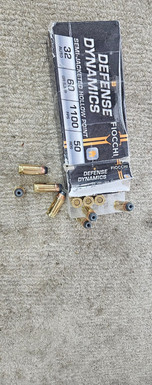The world of firearms ammunition can be both intriguing and overwhelming. If you've ever wondered what sets the India IOF .32ACP KF apart from imported .32ACP ammunition, you’re not alone. The .32ACP caliber is popular for its manageable recoil and affordability, making it a preferred choice for many shooters. This article will break down the important differences between these two types of ammunition, so you can make an informed decision.
What is the .32ACP Cartridge?
Before comparing the India IOF .32ACP KF with its imported siblings, let's look at the .32ACP cartridge itself. Developed by John Browning in the early 1900s, the .32ACP (Automatic Colt Pistol) was engineered for semi-automatic pistols. The caliber's low recoil, compact design, and effectiveness for self-defense have made it a favorite among firearm enthusiasts.
Typically, the .32ACP features bullet weights ranging from 60 to 95 grains and reaches a muzzle velocity of about 900 to 1,000 feet per second. This attributes to its recognition as a balanced choice for those seeking power without sacrificing control.
Overview of the India IOF .32ACP KF
The Indian Ordnance Factory (IOF) produces the .32ACP KF, a locally manufactured option that has gained popularity in India. Known for its reliability and affordability, this ammunition is often used by both beginners and seasoned shooters looking for a cost-effective choice.
The KF variant generally uses a Full Metal Jacket (FMJ) bullet to ensure consistent performance. Prices for this ammunition can be significantly lower than many imported brands, allowing for increased practice without breaking the bank. For example, while imported .32ACP might cost around INR 750-900 per round, the IOF .32ACP KF can often be found for approximately INR 100-150 each.
The Appeal of Imported .32ACP
On the other hand, imported .32ACP ammunition is produced by established manufacturers renowned for their quality. Brands like Fiocchi, Sellier & Bellot, and Hornady create products that are known for their precision and reliability. Imported ammunition uses advanced manufacturing techniques, leading to improved consistency and performance.
For instance, some imported cartridges achieve velocities of up to 1,200 feet per second and boast tighter tolerances, which leads to enhanced accuracy and reduced recoil. This performance can be critical for competitive shooters or those relying on their firearms for self-defense.
Major Differences Between India IOF .32ACP KF and Imported .32ACP
1. Quality and Consistency
One key aspect of the comparison is quality and consistency. Imported rounds undergo thorough testing and quality control measures to ensure performance reliability. For instance, specific brands may report a failure rate of less than 1% during testing.
In comparison, while many users find the IOF .32ACP KF satisfactory, there may be variability in performance, impacting accuracy and reliability. Users have noted occasional feeding issues or inconsistent discharge, especially in high-stress situations.
2. Cost Considerations
The cost difference between the IOF .32ACP KF and imported options is significant. The affordability of the IOF makes it appealing for budget-conscious shooters. For example, if a shooter practices frequently and fires 100 rounds per session, the cost difference can be substantial over time. An imported option might sum to INR 85,000 for regular practice versus INR 15,000 for IOF rounds.
3. Availability
In terms of availability, the IOF .32ACP KF enjoys an edge in India due to local production. It is usually readily available in regional markets. On the contrary, imported .32ACP might experience supply chain hurdles, import tariffs, or compliance with regulations, affecting consistent access.
4. Performance Aspects
Imported .32ACP ammunition often showcases superior accuracy and stopping power. For instance, a study of competitive shooters in India found that those using imported rounds had an average grouping of 1.5 inches at 23 meters, compared to 3 inches with IOF ammunition.
This means that if you are aiming for competitive events or need ammunition for high-stakes situations, imported options could serve you better.
5. Impact on Firearms
Finally, the ammunition type affects firearm performance. Imported ammunition typically adheres to high international standards, resulting in fewer malfunctions. A survey indicated that shooters using imported rounds experienced up to 30% fewer stoppages compared to those using the IOF .32ACP KF.
The more predictable functioning with imported rounds can be essential for defensive scenarios.
Final Thoughts
Choosing between the India IOF .32ACP KF and imported .32ACP ammunition involves considering your specific needs and preferences.
For budget-conscious shooters or those new to the sport, the IOF .32ACP KF represents an accessible option, allowing for practice and learning. However, for those emphasizing reliability and performance, investing in imported .32ACP ammunition might be beneficial despite the higher cost.
By understanding these differences, you can make a more informed choice that aligns with your requirements, whether it's for practice, competition, or personal defense.
If you've had experiences or insights regarding these ammunition types, we’d love to hear your thoughts in the comments!









Comments